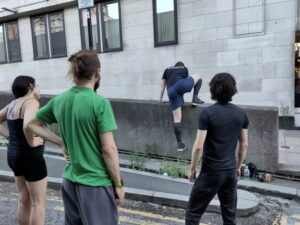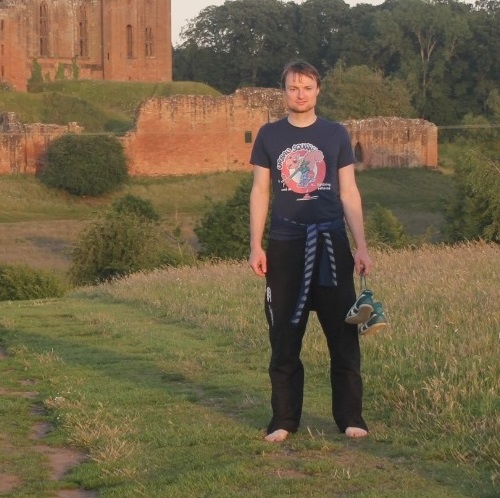Or: How training parkour has helped me manage being crippled
Our entire existence is movement, in one form or another. Yet most of it is unconscious, without attention, just happening as our routine patterns. But how about if we treated the everyday as a movement practice?
Recording: I recorded this post so that if you would prefer to listen instead of read, you can.
Introduction
Lets start with the quick issue of what a movement practice is. Essentially, it’s being intentional about how we move. Paying attention to our movement and directing the development of our movement in a particular direction. Usually this is about movements being fluid, easy and of a good quality, but it doesn’t have to be: some movement practices are about being strong, or coming across in a certain way.
Usually, practices are contained. Most people who play tennis might think about their posture, the distribution of weight in their body, and so on, while on the tennis court. But when they are driving in their car, there is no attention. Someone might be excellent at juggling, but when cooking dinner, move without awareness.
Someone who practises one movement practice – something which is more about how we move than just how to play one thing – will usually be able to transfer the quality of movement into another discipline. Often this will come with an accent, so to speak: when I started to dance, I danced like someone doing karate. But someone who does yoga, or climbing, or similar, will typically generally move better and pick up something like parkour more easily.
Some practices are intentionally open – about life in general. Mindfulness and breathwork are classic examples of practices which are about the entirety of life. Almost all sessions are just sitting or lying still while paying attention to the breath, cultivating a certain state of mind and mental abilities, and typically a particular way of breathing too. Yet the purpose is to transfer this state of mind to the rest of one’s life. As I am writing this, I am also paying some attention to my breathing and encouraging it to be deep and calm. While driving a car, the relaxed state of calm-focus is the best state of mind. I remember reading that snipers are taught mindfulness techniques. An artist might only be an artist when they are sat with pen and paper – or they might be the type of artist whose entire way of life is ‘art’. Does an actor also act when they are buying a coffee, or in an argument with a loved one? With martial arts, there’s a difference between sports which are just about bouncing around a padded space with another person and the type of training that also affects how you move around the city.
That’s what this post is about: treating the movement of everyday life as a movement practice.
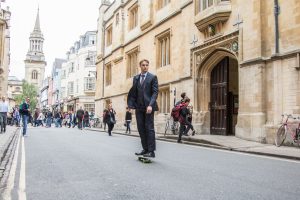
Injury, Posture, Awareness
When I was a teenager, I had a problem with my back and developed fractures in my spine (L5/S1, if you’re wondering). It happened over time, either due to a pre-existing weakness or simply from doing too much exercise without the muscles around the spine being properly engaged. Before the surgery, it was painful to stand for more than 20 minutes. Since the surgery, it becomes uncomfortable and then painful if I have to sit for longer than an hour. Vitally, a physiotherapist taught me about neutral spine position, how to hold my trunk properly and engage various muscles to support it. Not only did I have to do specific rehab exercises to strengthen my back muscles, but in everyday life I also have to have a good posture. Good posture is good for everyone, and most people will eventually have issues if they continue with bad posture. It just happens that my back is already weak, so my feedback happens much more quickly.
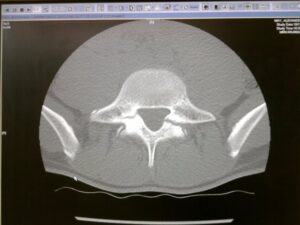
After learning how to hold my core properly while lying down, I then learned it standing. It turns out there should always be some muscle engagement, usually only about 20%. Then, I had to learn it while running. Now, when I’m running, my core is engaged the whole time, and when my foot touches down, the muscles engage through the foot, the leg, through the bum as the connection between leg and back, and into my core. If you aren’t doing this, then your back is taking a slight pounding, and probably your leg isn’t as springy either, so the knees or hips will also be taking more impact. When I have taught this to a couple of students with back issues, they are shocked to find that they should be thinking about their posture the entire time they are running. But after awhile of conscious practice, it becomes pretty normal. It is now internalised as part of my running, and while sometimes if my body or mind are tired my form gets worse and I have to consciously engage it, it mostly happens subconsciously.
When I was 20, I was at a parkour session led by Blane, a legendary British parkour coach, and he did something which also became part of my coaching practice. After watching me landing some jumps, he came over and said, “Have you noticed how when you land, your right foot is always turned out?”. I said I had noticed but wasn’t sure what to do about it, and I asked him how big a problem it is. He replied something along the lines that in the short-term there’s no problem, but sometime over six months to two years, it might cause problems. I’ve since had a similar conversation with many students I have taught, or sometimes with their parents, if I notice something wrong in how one of their legs moves. Our bodies adapt, and many people have these imbalances or maladaptations in how they move, but it can cause a problem down the line: if the foot is always twisted, then the knee might be in bad alignment and take damage.
So, I got to work. When landing, I paid attention to my foot position, aligning it properly before I landed. I noticed that every time I ran, my foot was landing slightly twisted. I worked on consciously straightening it in the middle of the stride so that it could land in good alignment. Then I noticed that even when I walked, my foot was always twisted. So I also turned my attention to placing it better when walking.

It was around the same time that I became aware of the ‘barefoot’ style shoe. The basic idea is that adding a chunk of padding on the bottom of our foot isn’t that great for the rest of our bodies. Instead of the muscles in our feet engaging to absorb the shock, we just squash a lump of rubber at the end of our leg down onto the floor and walk over it. Shoes aren’t necessarily bad, but they can mean that our muscles aren’t properly engaging, and this can mean that we have less control and that there is more shock going through our legs that can cause knee, hip or back issues. So, I started paying more attention to how I walk: engaging my arch and toes, pushing off properly. This tied in well to the posture I was thinking about for my back, as it is all connected.

So, over time, my everyday walking changed from this back injury and from this parkour coach spotting my twisted foot. This isn’t just physical: it’s ultimately about the state of mind. (Remember: our mind and body are not seperate but are an integrated mindbody; how we move and how we think are the same thing, not different things.) Walking is now something I do mindfully, most of the time at least. When you begin to practice like this is takes a lot of focus, but after some time, it becomes internalised. This is what mindfulness is about: the posture of our body and how we walk is within our awareness, but it doesn’t consume it. We can still be having a conversation, daydreaming, singing, or whatever, while also having our posture and walking within our awareness.
I first learned this sort of awareness as a child, walking around my house quietly. I can’t remember if it was because my mum was a light sleeper, or that I just made a game of avoiding the creaks in the floor, but either way, I used to sneak around. The way you step is different – the new foot is placed without weight, then the weight is gradually transferred. You also have to learn the environment, where to step, where not to step. In a way, this gentleness of movement is also part of my personality: tread softly, be gentle, don’t disturb people.
One final example. Most of us know that hunching over a computer or mobile phone is bad for our posture. This is, sort of, a movement practice. If we spend a lot of time hunched over our phone, our body adapts to it. Our shoulders roll forwards, our neck tips down, our spine curves. I tried to train myself instead to hold my phone up towards my face. I mounted my shoulders properly, scapula engaged, thoracic spine upright, elbows tucked into my body, and brought the phone up to my eyes instead of my eyes down to the phone. It takes effort, physical and mental effort, but it’s both healthier and reminds me to breath deeply, to relax, to try and relax against whatever dopamine scrolling machine is clawing from my screen into my brain.
Playfulness
This makes walking seem some boring, solemn thing in which I am constantly processing like a monk. But it is also playful. Alongside parkour, I played rugby, trained martial arts, and did a bit of salsa. Walking down the street, I might skip sideways as part of my normal way of flowing through people. I noticed I did this diagonal step-behind thing to have this lateral movement. Writing it like a dance step: I would be walking head-on towards another person and realise I needed to move sideways; after placing my right foot, I shifted my weight to the right, overbalancing, my momentum moving forward and right; then a hop off my right as my left came through behind the right, landing on my left behind me and then continuing a forwards walk from there. Perhaps I picked this up from watching the original West Side Story film. Adding in parkour, often going over a wall or fence was a normal part of getting around. At the pelican crossing with traffic lights and a fenced island in the middle, I could go a gentle vault over the fence to get around.
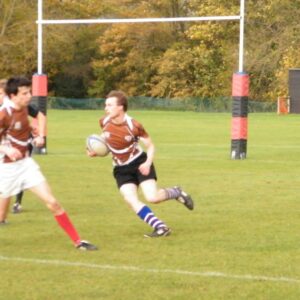
I cycled, too, commuting the same 10km to Hammersmith and back twice a week for years. Cycling could be a relaxing meditation while I listened to a podcast or thought something through. It could be an aggressive battle with other road users jostling for space on the road. It can be a logic puzzle as I learned the sequences and timings of the traffic lights on this route, and would adjust my pace half a minute before the lights based on when the gap was. But most fun of all was the dance, weaving around the road with the flow of traffic. Changing lanes, finding the space, or just fitting in with the flow when it was busy.
In indoor situations, how I sat down became a dance too. Move like water, parkour with the chair. Parkour training teaches us that it isn’t a sequence of individual moves one after the other, but one continuous movement. Mid-air in a vault, the movement changes based on what happens next: shifting the weight left and landing left-right-PUSH to change course; or coming together for a compact landing ready to explode into a jump. The same works with interacting with the chair. As a hand pulls the chair back, there’s a fluid-step-skip to go around it, smoothly cutting in diagonally with some weight on the table to hook the other foot behind a chair leg to pull it in underneath you. Smooth, quiet, controlled, fluid, and fun.
I talked earlier about walking quietly around the house. I also flow through the space with the same carefulness. When my hands touch doors, they don’t collide but engage, press, ease. I push them only as much as they need to, so that they don’t swing into the wall. Sometimes I use other parts of my arm on them, like my shoulder. It’s a game, a dance, going from room to room.
My favourite is around the kitchen. The realisation that you can sway and lean to reach between things, or that after opening a cupboard to pick something up from inside, the cupboard can be closed by an elbow or a shoulder while moving to wherever you are taking what has been picked up. Low down cupboards are fun because the legs can get involved, hooking a foot or pushing with the thigh while the hands are already moving towards what is next. I’ve long wanted to capture this in a video, turn it into a dance choreography, but never got round to it.
The mindfulness is also the playfulness; it’s being aware that makes the play possible.
Illness as a movement practice
Then a year ago I became ill, and discovered a different side of the everyday movement practice. We all know that physical injury changes how we move. If you hurt an ankle, you limp, and stairs become difficult. Put an arm in a cast, suddenly showering or washing up are totally different.
After catching Covid-19, I developed long covid. It’s been life changing, and it’s unclear the extent to which I will recover afterwards – though here I’ll just talk about the movement side of things. I wasn’t surprised, I knew it was possible – two close family members have had chronic fatigue syndrome, and I’ve had a couple of periods in my adult life of having strangely less energy for periods of time. Suddenly, my body functions differently. My cells don’t metabolise energy properly, my blood vessels don’t work properly, my autonomic system is dysfunctional.
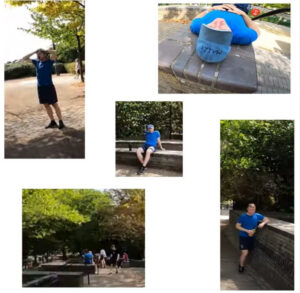
The practice of breathing becomes important as it turns out that my body doesn’t automatically breath more when I start walking. I have to learn to consciously add more breaths. I realise that there is an invisible threshold in my body that if I cross will cause exhaustion. Something about the cells not metabolising properly, and running out of energy instead of being replenished, which then causes fatigue. Sometimes the fatigue happens immediately, and I find myself sitting on the floor in the middle of a game of badminton. Or perhaps that came from autonomic cardiovascular dysfunction, and there wasn’t enough oxygen getting around, and that’s why I got tired and had to sit down suddenly.
Sometimes there isn’t fatigue at the time, but some threshold was crossed deeper inside me, and half a day later, it feels like the inside of my body is sludge. I would cycle somewhere, feel fine at the time, not yet recognising the signs that a crash was to come, and that after cycling my body hadn’t become relaxed. The next day I would wake up, have no energy, and feel terrible.
Living with this condition became a movement practice. It was a mindfulness practice too, with the breathing practice and consciously learning how to relax being more important than it had been before. But it also changed how I moved.
I had to learn to walk differently. If I ‘just walked’, I would go too fast, at least initially. I learned to walk slowly. I learned also to keep an eye on the Garmin watch I was wearing to check my heartrate hadn’t gone up too much, which meant I had gone off too fast. Usually, after about fifteen minutes, my body was ready to walk normal speed. I remember one walk where a minute after leaving the car, I felt weak. I sat back down, breathed, and then started walking slowly. After ten slower minutes, I hiked up a hill for an hour.
Going up stairs, I have now learned to either go very slowly, or to pause for ten seconds every three steps. Going upstairs is much more intense for our bodies than walking on the flat. A healthy body can handle this, using an initial store of energy while adjusting to have more blood flow so that aerobic respiration can happen at a higher intensity. A long covid body cannot do that. I have learned to do other things differently too, and to not do lots of things. I get up from the floor slowly, not quickly. I can’t carry heavy things, so if I have wet laundry to hang up, I only carry a third of it at a time. At my worst, I moved a chair to the kitchen sink so that I could do the washing up sitting down, in 30-second bursts. On an online support group, I tell people that when they get out of bed to walk to the toilet, they should walk slowly, not normal speed, so that the transition is easier for the body.
Training is for life
Training is for life – which includes the everyday and the extremes. It turns out, most of what we learn in physical disciplines isn’t just about the typical confines of that discipline. It can be, of course. You can get really good at table tennis and the rest of your life doesn’t change much. But it can teach you to shift your balance, be light on your feet, and so on. Yet if we are serious about a movement practice, it’s about learning how to move. Yoga is a great example. As an exercise, it cultivates flexibility and muscle strength. But it also a mindful awareness and how to pay attention to your whole body at once. It teaches you how to breath when under stress, and how to stay relaxed in stressful situations.
As I grew up, and did some strength training, I became strong enough to carry things, or to carry someone if I need to. Rugby taught me how to try and run past someone with a ball, but also how to walk around the pavement without getting in people’s way. From parkour and martial arts I have learned how to fall over without getting hurt. From climbing, I can get over walls and up buildings if I ever need to. Martial arts taught me how to fight if I need to, but most importantly, that it’s really important to avoid a fight.
I knew all of those practical uses, and thought that was the main thing I was training for. Yet since becoming crippled by long covid, it turns out that the general notion of a movement practice has been the most important yet. Where my fluid movements used to help me going fast over walls, now they help me to move around gently and not exhaust myself. And perhaps most importantly, how to breath and relax when I need it most.
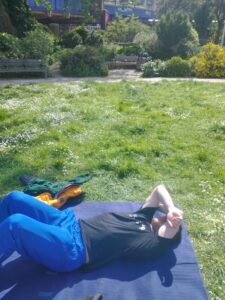
I am currently teaching parkour as a movement practice in London. This is an accessible class open to beginners with no parkour experience or fitness level necessary. (I mean it! I have taught parkour to people who have not done any exercise for years, have physical impairments, get panicked easily, and so on. It really can be for (almost)* anyone.) More information here.
